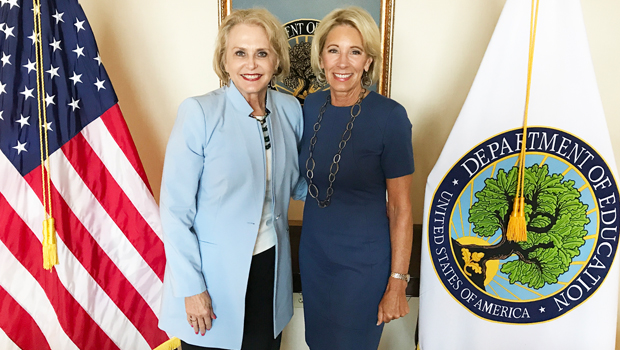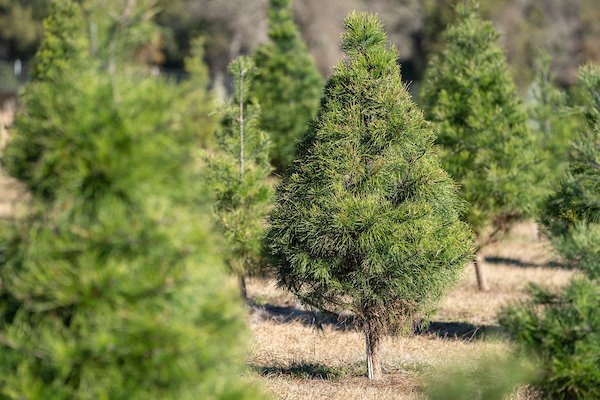NEWS
NCTC VP attends Rural Community College Alliance Day in D.C.

North Central Texas College Associate Vice President of Strategic Partnerships Dr. Emily Klement recently returned from the Rural Community College Alliance Day on the Hill event in Washington, DC on July 18.
Klement was among 15 representatives from across the country representing community colleges at several events which included the Department of Education, United States Department of Agriculture and U.S. Representatives and members of the Senate staff.
Included was a roundtable meeting with U.S. Secretary of Education Betsy DeVos, where each representative spoke to her on the critical needs of rural America in areas of workforce education, economic development and access for students and communities.
Read the full story in the mid-week News.
NEWS
Demand for live Christmas trees continues to rise

Demand for Texas-grown Christmas trees continues to rise as acreage and entrepreneurial interest in farms expands, according to a Texas A&M Forest Service expert.
Texas Christmas tree farms continue to see high demand for choose-and-cut trees. (Laura McKenzie/Texas A&M AgriLife)
Fred Raley, Ph.D., Texas A&M Forest Service director of the Western Gulf Tree Improvement Program, said Texas Christmas tree producers fared well this year after back-to-back seasons of drought for much of the state. He said consumers should expect higher prices for choose-and-cut and shipped cut trees this holiday season.
“Demand is up, whether the previous seasons impacted supplies or supplies held steady, so there is a potential for price increases and limited selection,” he said. “The increased cost of shipping in fresh-cut trees from other states will also factor into prices.”
Growers, farms diversify around Christmas trees
Raley said the impact of drought depended on localized rainfall and growers’ access to irrigation. Some farms are supplementing their native tree stocks with more shipped trees this year.
“If you want a live tree, my advice would be to get one early for the best selection,” he said.
Raley said sales typically kick off the weekend following Thanksgiving. Farms have been busy ordering trees and preparing their farms for sales season. In North Carolina, tree damage and impassable roads were concerns regarding Christmas tree supplies following the flood damage from Hurricane Helene. However, there was limited damage following the storm to farms and roads have been restored.
Texas producers continue to expand their acreage where they can, Raley said. Many choose-and-cut farms are also diversifying their operation with “experiential services” built around Christmas trees like hayrides, do-it-yourself decoration/wreath making and games.
“They’re trying to build a complete seasonal experience,” he said. “We’re seeing some older generational farms closing, but we’re also hearing from younger entrepreneurs who want to do something in the green industry, and they are looking to start with Christmas trees.”
Demand for replacement seedlings continues to rise
Stan Reed, executive secretary of the Texas Christmas Tree Growers Association, said the organization is seeing similar expansion and diversification trends in the industry across Texas. He estimates there are 85-95 tree farms in Texas that range from small “mom and pop” growers-sellers to 60-70-acre operations.
“Texas doesn’t have any growers who serve the wholesale market, but there are two operations that are poised to enter that market, which will serve local-cut live-tree stands,” he said.
Reed said new information and methods are helping growers increase production and limit setbacks like lost seedlings. There are four primary tree varieties that perform well in Texas growing conditions – Virginia and Afghan pines, and Leyland and Carolina sapphire cypresses.
Christmas trees in Texas are typically grown in four-year rotations, he said. The association sells seedling Virginia pine trees started from seed banks created by the Texas A&M Forest Service at a discount to growers.
Reed said growers have purchased around 130,000 seedlings so far for their upcoming replants.
Growers have been encouraged to buy more trees than they will plant to replace the season’s harvest. Those excess trees are kept as potted trees and are available to replace seedlings that do not establish and survive. Over the years, Reed said some growers have begun taking advantage of keeping trees potted longer to expedite their growth and shorten their harvest time to three years.
Raley said the seedling program started in the early 2000s, and research trials around the state have identified trees and varietal germplasm that are resilient and perform best. Seed from selected high performers grafted in seed orchards are used to create the seedlings supplied through the association.
“That program is about continuous improvement, and our goal is to meet or exceed the demand of growers each season,” Raley said. “That’s become a challenge because those numbers keep going up every year, but we want to continue to see that trend.”

The Bowie News office will be closed Thursday and Friday so our staff can enjoy time with their family and friends. We hope everyone has a safe and wonderful holiday. See you in December!
NEWS
Texas Comptroller Glenn Hegar transfers $5.5 billion to state highway and Rainy Day funds

(AUSTIN) — Texas Comptroller Glenn Hegar announced today he has completed the transfer of about $5.48 billion into the State Highway Fund (SHF) and the Economic Stabilization Fund (ESF; commonly known as the “Rainy Day Fund”). Each fund received about $2.74 billion, or 50 percent of the total transfer.
“These transfers into the ESF and SHF show the Texas economy remains strong and well positioned for continued growth albeit at a much more moderate pace than what we have seen in recent years,” said Hegar. “Although inflation has come down from the historic levels reached during the current administration, uncertainty remains in the global economy as consumers continue to grapple with elevated prices on everything from groceries to home and auto insurance, and geopolitical instability persists.
“That uncertainty is why lawmakers have safeguarded the Texas Rainy Day Fund and continued to invest in our transportation infrastructure. A healthy ESF balance provides a critical cushion against any future bumps in the road and gives the Legislature increased flexibility as they convene to tackle the critical issues important to Texans.”
The combined $5.48 billion severance tax transfers to the ESF and SHF are based on crude oil and natural gas production tax revenues in excess of 1987 collections. If either tax generates more revenue than the 1987 threshold, an amount equal to 75 percent of the excess is transferred.
In November 2014, voters approved a constitutional amendment allocating at least half of these severance taxes to the ESF, with the remainder going to the SHF for use on non-toll highway construction, maintenance and right-of-way acquisition.
According to the Texas Constitution, the ESF and SHF transfers must occur within 90 days after the end of the fiscal year.
When fiscal 2024 ended on Aug. 31, the ESF balance was $21.02 billion. With the most recent transfers, the new ESF balance is about $23.96 billion, not accounting for currently outstanding spending authority of approximately $486 million. The balance in the ESF will change as agencies spend down this remaining appropriation authority and investment earnings are realized.
-

 NEWS2 years ago
NEWS2 years ago2 hurt, 1 jailed after shooting incident north of Nocona
-

 NEWS1 year ago
NEWS1 year agoSuspect indicted, jailed in Tia Hutson murder
-

 NEWS2 years ago
NEWS2 years agoSO investigating possible murder/suicide
-

 NEWS2 years ago
NEWS2 years agoWreck takes the life of BHS teen, 16
-

 NEWS1 year ago
NEWS1 year agoMurder unsolved – 1 year later Tia Hutson’s family angry, frustrated with no arrest
-

 NEWS2 years ago
NEWS2 years agoSheriff’s office called out to infant’s death
-

 NEWS2 years ago
NEWS2 years agoBowie Police face three-hour standoff after possible domestic fight
-

 NEWS2 years ago
NEWS2 years agoDriver stopped by a man running into the street, robbed at knifepoint





